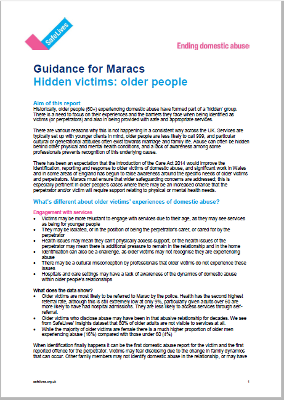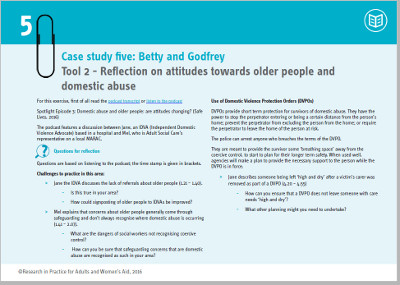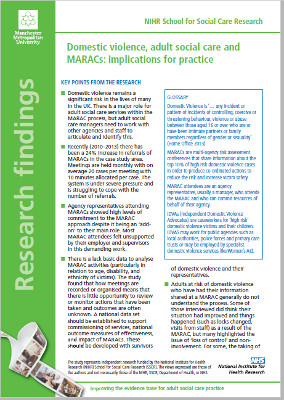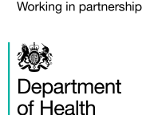Download the whole case study as a PDF file
Summary
Betty and Godfrey are an older married couple. Godfrey received a diagnosis of dementia 18 months ago, and has been attending a respite centre two days per week to support Betty to cope with her caring role. The day centre staff have observed Betty being rough with Godfrey and so raised a safeguarding concern with Adult Social Care – but looking into Betty and Godrey’s file, it becomes apparent that Godfrey has been abusive to Betty in the past.
This case study considers issues around working with older people experiencing domestic abuse, dementia and longstanding abuse, and carers as perpetrators and victims of domestic abuse.
When you have looked at the materials for the case study and considered these topics, you can use the critical reflection tool and the action planning tool to consider your own practice.
Case details
Download the case details as a PDF file (550KB)
Betty and Godfrey have been married for 52 years. Betty is originally from Barbados and Godfrey from St Kitts. They have three children. Marcus and Gloria live in the USA. Angela, who is a carer for her son with complex needs, and her husband live nearby.
Godfrey is living with dementia after a diagnosis 18 months ago. Their GP made a referral for a carer’s assessment for Betty due to her being stressed due to Godfrey’s ‘increasingly unreasonable demands’. As a result Godfrey attends a day care centre two days a week to give Betty some respite. Godfrey is described as ‘a real charmer’ and is popular with the staff and centre members.
The centre staff have noted that there is a ‘volatile’ relationship between Betty and Godfrey. Incidents include Betty trying to drag Godfrey out of the car to get him into the centre and Betty talking sharply to Godfrey because he was refusing to leave the centre when she came to pick him up. The staff find Betty trying at times. She gives them very specific instructions about how to provide support to Godfrey, for example what he can and can’t eat. They have found Godfrey likes food that Betty says he doesn’t like.
Recently staff assisting Godfrey found that he had bruising on both of his upper arms. A nurse who was visiting said they could be from being grabbed. Godfrey said that it was true, Betty had grabbed him when they were having a row, but that it was nothing to worry about ‘just the ups and downs of married life’. The nurse told Godfrey about safeguarding and he said he didn’t want a referral made.
When the nurse discussed this with the centre manager they decided that as Godfrey might not have had the capacity to make the decision about going ahead with a safeguarding referral because of his dementia, and because he might be at risk of harm before his next day at the centre, they would make a safeguarding referral.
Notes on Godfreys and Betty’s social care files refer to the police having attended the household twice in the last 8 months after calls from Betty during the late evening in which she said Godfrey was out of control and hurting her.
How would you make safe enquiry with each of Godfrey and Betty?
Who will meet with each of them?
Where?
How will you contact them to arrange the meeting?
Assessment
In this section are two downloadable PDFs – one is a partly completed assessment form related to this case study, and another is an example of what a completed form could look like.
Suggested exercise
Download the partly completed assessment as a PDF file (503KB)
Download the completed assessment as a PDF file (502KB)
Use the partly completed assessment form:
- What actions would you discuss with Betty to ensure her immediate and longer term safety?
- What precautions would you need to take to avoid putting her at higher risk of harm?
- What is your analysis of the situation? Is coercive control occurring? What is the evidence of this?
- What is your conclusion?
DASH- RIC
Download the blank DASH_RIC as a Word .doc file (226KB)
The purpose of the DASH risk checklist is to give a consistent and simple tool for practitioners who work with adult victims of domestic abuse in order to help them identify those who are at high risk of harm and whose cases should be referred to a MARAC meeting in order to manage their risk. If you are concerned about risk to a child or children, Safe Lives recommend that you should make a referral to ensure that a full assessment of their safety and welfare is made.
There are two downloads on this page.
One shows a blank DASH risk checklist, with quick start guidance from Safe Lives. The key point is to remember that your professional judgement is key in making a decision about risk; a tool can help, but the score it comes out with is not definitive.
This is especially relevant when working with people with care and support needs, for whom some of the questions may not be relevant.
Download the case study DASH-RIC as a PDF file (206KB)
The other shows an example of a completed DASH relating to this case study, for you to critique and appraise.
Suggested exercise:
- Read the case details and full assessment document for this case study.
- Using the information contained, fill out a blank DASH risk assessment tool.
- Discuss how you found it; did you have all the required information? Would you be able to get all the required information in practice? Would you make a referral to MARAC?
Topics
This section picks out three main topics from the case study featured. For Betty and Godfrey’s case study, the topics include:
- Working with older people experiencing domestic abuse/lifelong coercive control
- Dementia and longstanding domestic abuse
- The role of the MARAC
A selection of references, tools and further reading for each topic is below.
Working with older people experiencing domestic abuse/lifelong coercive control
‘A review of the impact of domestic abuse for older women in Health and Social Care in the Community in 2011 highlighted that the issue is significant but that health and social care professionals fail to recognise domestic abuse between older couples.’
This is referred to in an article by Natalie Valios, 26 March 2015, in Community Care which summarises the outcome of the serious case review into the death of Mary Russell. The article offers key pointers for social workers and provides useful links:
http://www.communitycare.co.uk/2015/03/26/domestic-abuse-doesnt-stop-at-60/
McGarry et al’s (2011) review of the literature investigating older women’s experience of domestic abuse points to the longer term effect of physical abuse, the psychological impact at the time and cumulatively in later life, and emotional issues which many felt unable to disclose to others – a significant barrier to reporting in older age being that women ‘had kept their experiences ‘hidden’ from family friends and neighbours’ for many years.
The voices of older women survivors – in the accounts of sixteen women, aged 63-79, who had experienced domestic abuse – are highlighted in McGarry and Simpson, (2011).
McGarry et al (2011) also detail some information on the lack of research on the experiences of older women from ethnic minorities, concluding that ‘taken as a whole, the voices of older women from ethnic minorities remain unheard and this clearly represents an additional deficit in knowledge and understanding.’ (2011:11) Social workers working with Betty will need to consider possible limitations of their knowledge base and be proactive in this respect.
Case study 1 Ayesha focuses on intersectionality and building cultural capability.
Advice for health and social care professionals – for example those working in care homes who may be particularly well placed to support older people to begin to talk about domestic abuse and coercive control in their intimate relationships – is available here:
Live Fear Free: Supporting a client who is experiencing domestic abuse or sexual violence.
‘Safe Lives’ offer a range of useful information on working with older people experiencing domestic abuse:
http://www.safelives.org.uk/node/861
Dementia and longstanding domestic abuse
There is a surprisingly limited amount of research on this topic although findings from Dr Lucy Knight and Professor Marianne Hester’s research highlights that the onset of dementia in the situations studied led to an escalation in the severity of the domestic abuse:
http://www.rcpsych.ac.uk/pdf/Knight%20Lucy.pdf
Other papers look at issues related to but not quite focused on the experience of domestic abuse for people with dementia, for example ‘elder abuse’. The lack of separation of domestic abuse and coercive control from ‘elder abuse’ in the literature to date makes it difficult to draw conclusions about domestic abuse and older people.
Blog post: Perpetrators with dementia
Case study example from Solace Women’s Aid: Older domestic violence victims feel helpless in the face of long-term abuse
Podcast: For their Spotlight series, Safe Lives have developed a number of podcasts which explore issues relating to domestic abuse and people with social care needs. One of these is focused on changing attitudes towards older people and domestic abuse.
Access the podcast recording here: Domestic abuse and older people: Are attitudes changing?
Access the transcript of the podcast here
See also Tool 2, Reflection on attitudes towards older people and domestic abuse.
The role of the MARAC
A useful summary of research findings on MARAC processes has been produced by NIHR School for Social Care Research and Manchester Metropolitan University which recognises that MARAC domestic violence processes and safeguarding processes may need to be followed in parallel. This can be found in Tool 3, below.
‘MARACs are ‘multi-agency risk assessment conferences’ that share information about the top 10% high risk domestic violence cases in order to produce co-ordinated actions to reduce the risk and increase victim safety.’
Rachel Robbins et al’s (2014) paper draws attention to the potential and limits of the Multi-Agency Risk Assessment Conferences (MARACs) in supporting adults with social care needs who also experience domestic violence.
Tool 1 below gives specific guidance on MARAC processes with older people.
‘MARACs are ‘multi-agency risk assessment conferences’ that share information about the top 10% high risk domestic violence cases in order to produce co-ordinated actions to reduce the risk and increase victim safety.’
Rachel Robbins et al’s (2014) paper draws attention to the potential and limits of the Multi-Agency Risk Assessment Conferences (MARACs) in supporting adults with social care needs who also experience domestic violence.
Tools
Tool 1: Safe Lives guidance for MARACS, hidden victims: older people
Tool 2: Reflection on attitudes towards older people and domestic abuse
Tool 3: NIHR Domestic violence, adult social care and MARAC
Tool 1: Safe Lives guidance for MARACS, hidden victims: older people

Download the tool as a PDF file (191KB)
Historically, older people (60+) experiencing domestic abuse have formed part of a ‘hidden’ group.
There is a need to focus on their experiences and the barriers they face when being identified as victims (or perpetrators) and also in being provided with safe and appropriate services.
There are various reasons why this is not happening in a consistent way across the UK. Services are typically set up with younger clients in mind, older people are less likely to call 999, and particular cultural or generational attitudes often exist towards marriage and family life. Abuse can often be hidden behind other physical and mental health conditions, and a lack of awareness among some professionals prevents recognition of this underlying cause.
There has been an expectation that the introduction of the Care Act 2014 would improve the identification, reporting and response to older victims of domestic abuse, and significant work in Wales and in some areas of England has begun to raise awareness around the specific needs of older victims and perpetrators. Maracs must ensure that wider safeguarding concerns are addressed; this is especially pertinent in older people's cases where there may be an increased chance that the perpetrator and/or victim will require support relating to physical or mental health needs.
This tool outlines:
- What is different about older victims’ experiences of domestic abuse?
- What should happen before MARAC?
- Who are the right people to be at the table?
- What research to do before the meeting (e.g. impact of abuse on the victim, and their views and wishes)
- What representatives from different agencies should offer
- What effective action planning during MARAC looks like
- Tips for professionals working outside the MARAC
[_/su_spoiler]
Tool 2: Reflection on attitudes towards older people and domestic abuse

Download the tool as a PDF file (534KB)
For this exercise, first of all read the podcast transcript or listen to the podcast
Spotlight Episode 3: Domestic abuse and older people: are attitudes changing? (Safe Lives, 2016)
The podcast features a discussion between Jane, an IDVA (Independent Domestic Violence Advocate) based in a hospital and Mel, who is Adult Social Care’s representative on a local MARAC.
The tool highlights sections of the podcasts as a reference to start off discussion and debate about practice in your areas.
It includes reflective questions on issues including:
- Challenges to practice in this area
- Use of Domestic Violence Protection Orders (DVPOs)
- Identifying coercive control
- The line between concerned or stressed carer, and perpetrator of domestic abuse
- Barriers to older people accessing support
- The use of MARAC
[_/su_spoiler]
Tool 3: NIHR Domestic violence, adult social care and MARAC

Download the tool as a PDF file (160KB)
This tool summarises a study which was interested in identifying and assessing the effectiveness of social care’s contribution to the development of MARACs and the protection of adults facing domestic abuse, using the city of Manchester as a case study site.
The researchers attended MARACs, interviewed members of MARAC partner agencies and adult social care workers, undertook focus groups with survivors of domestic violence, and focus groups with specialist domestic abuse practitioners.
The 4-page summary outlines:
- Key points from the research
- Background
- Findings: service user perspectives
- Findings: agency perspectives
- Interviews with adult social care
Questions for reflection on reading the report are outlined below.
- What is the threshold for MARAC in your area?
- How would you use your professional judgement to make a case for an older person who might not meet the threshold for MARAC, but is at high risk, to be included in MARAC?
- Can you see any tensions between using a Making Safeguarding Personal approach, and MARAC?
- How can these tensions be overcome?
References
There is also comprehensive reference to MARAC procedures in the LGA & ADASS guide to support practitioners and managers which is available here:
(see also Case study 3 John Topic – Complex caring relationships)
Further reading:
Knight L and Hester M (2014) Domestic abuse and dementia: what are the characteristic features and patterns of longstanding domestic abuse following the onset of dementia? Safe Vol 48 (4) pp 10-14.
McGarry J, Simpson C and Hinchliff-Smith K (2011) The impact of domestic violence on older women: a review of the literature. Health and Social Care in the Community, 19,1, 3-14 Available here: http://onlinelibrary.wiley.com/doi/10.1111/j.1365-2524.2010.00964.x/full
McGarry J. & Simpson C (2011) Domestic abuse and older women: exploring the opportunities for service development and care delivery. The Journal of Adult Protection, 13, 6, 294-301. Available here: http://www.reducingtherisk.org.uk/cms/sites/reducingtherisk/files/folders/resources/victims/Domestic_abuse_and_older_women_McGarry_and_Simpson.pdf
Robbins R, McLaughlin H, Banks C, Bellamy C, Thackray D (2014) ‘Domestic violence and multi-agency risk assessment conferences (MARACs): a scoping review’, The Journal of Adult Protection, Vol. 16 (6), pp.389 – 398








